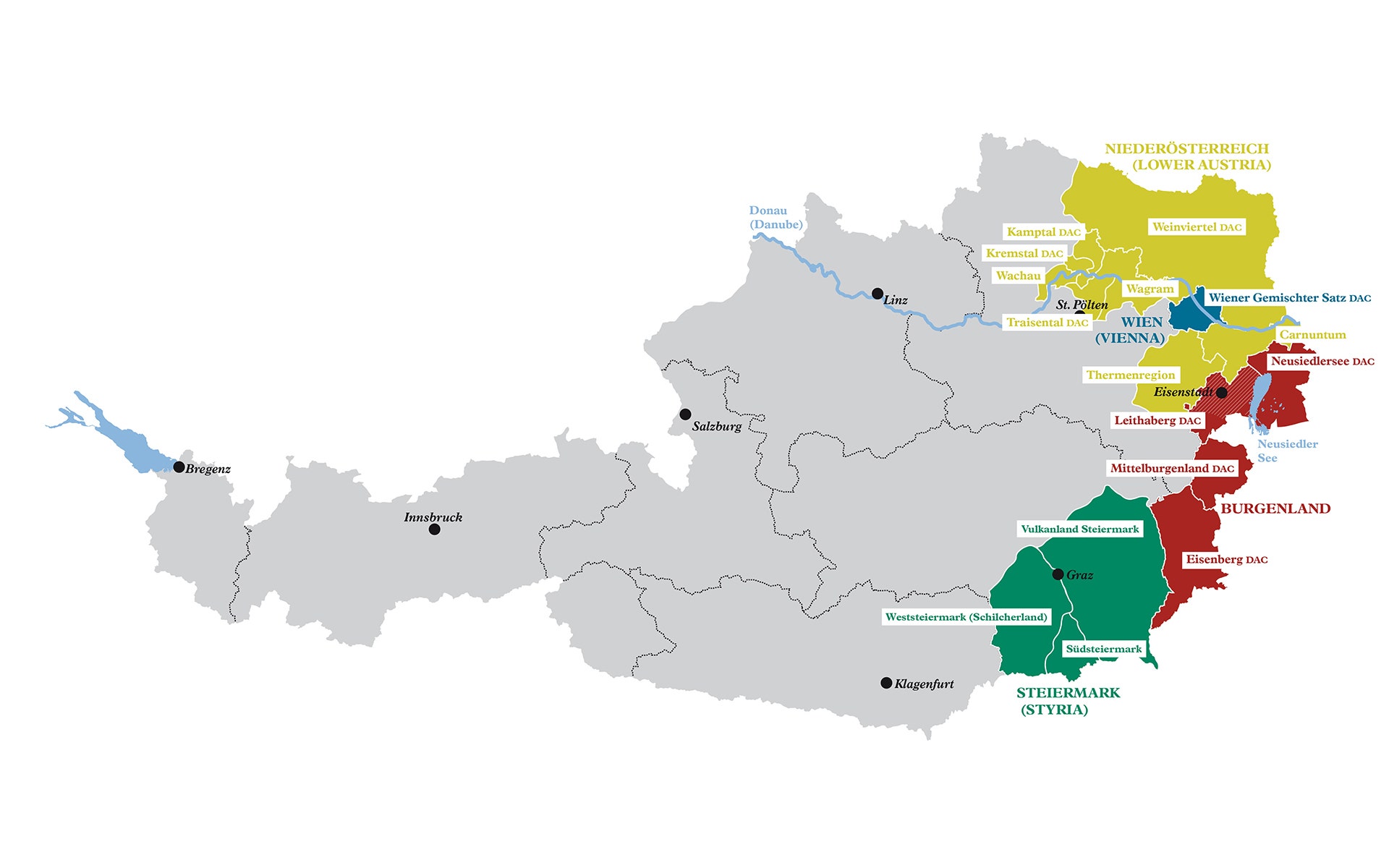The Sound of Music. Gustav Klimt and Egon Schiele. Mozart opera and Viennese waltzes. Snooty waiters in coffee houses serving sachertorte. You may not associate Austria with wine when so many cultural icons vie for attention, but it’s central to the culture of this tiny Alpine republic.
What sets Austria apart is that the country has made its name from essentially one indigenous grape variety, Grüner Veltliner. It also produces Blaufränkisch, Zweigelt and St. Laurent, along with a few other varieties grown exclusively there.
Austria is punching far above its weight and the wine world agrees. Exports are booming, and wherever you are, there’s surely some Grüner nearby. But while the country is small, it’s very diverse. Its producer base is comprised of mostly small, family-owned estates, which makes Austria the antithesis of high-volume, industrial-scale winemaking.

The geography
In terms of size, Austria produces less than a quarter of California’s entire output. While the Alps are the country’s most distinct geographic feature, all of its vineyards are in the east and south of the country. There, soft hills ease to the east into the Pannonian plain toward Hungary, south toward Slovenia and north toward the big skies of Moravia in the Czech Republic.
The climate in this landlocked corner of Central Europe is deeply continental, with cold, snowy winters, warm summers and extended, sunny autumns, to which the indigenous grapes are well adapted.
Austria’s winemaking regions
Austria’s wine country is divided into three parts, which split into smaller regions. Niederösterreich (Lower Austria) is to the northeast along the river Danube, its tributaries and surrounding Vienna. Burgenland is to the east, and Steiermark, or Styria, is in the south. As for Vienna, it’s the world’s lone capital with a significant wine industry within its city limits.

Niederösterreich
Niederösterreich boasts 60 percent of Austria’s vineyards, and is comprised of the eight regions. Along the Danube, Wachau, Kremstal, Kamptal, Traisental and Wagram are to the west of Vienna; Carnuntum and Thermenregion to the south and east of Vienna; and the vast expanse of the Weinviertel extends north and east of Vienna toward the Czech Republic and Slovakia.
The Weinviertel, literally “wine quarter,” has slaked Austrian thirst for centuries. On the same latitude as the Champagne region, it has always made lighter, easy-drinking styles with lots of freshness. It’s where most base wines for Austrian sparkling wine, or sekt, are grown, and where Grüner Veltliner reigns supreme.
Weinviertel’s fortunes changed in 2003 with the introduction of the first-ever Austrian Districtus Austriae Controllatus (DAC), a legal appellation that connected regions with a particular grape variety.
DACs represent Austria’s shift away from a German-style law based on region and ripeness to a French model that favors typicity. The Weinviertel DAC is known for fresh, peppery Grüner Veltliner, but you can also find Zweigelt, Riesling and field blends here. In Niederösterreich’s Danubian regions of Wachau, Kremstal, Kamptal, Traisental and Wagram, white wines reign supreme. Home to Austria’s most famous vineyards, this is where ageworthy, single-vineyard Grüner Veltliners and Rieslings are grown. Rocky soils of gneiss, quartz, gravel, loess and sand dominate.

Wachau is at a narrow stretch of the Danube, and its steep, southern-facing vineyards bring forth expressive whites. The Wachau, quirkily, has its own classification based on the ripeness of its dry whites: Steinfeder, with a maximum of 11% abv; Federspiel, with a max of 12.5% abv; and Smaragd, with a minimum of 12.5% abv.
Kremstal adjoins the Wachau and makes similar wines of equal quality, as does Kamptal, which has storied vineyards along the Danube tributary, Kamp.
Traisental, on the Traisen river south of the Danube, makes equally long-lived wines, but on lighter feet, due to its calcareous soils. Kremstal, Kamptal and Traisental are all DACs for dry Riesling and Grüner Veltliner.
Wagram, a vast bank of loess along the Danube, is famed for rounded Grüner Veltliner and increasingly, for fine Pinot Noir.
South of Vienna, the Thermenregion is home to two of Austria’s most unusual indigenous grape varieties: Zierfandler, with pronounced texture and freshness, and aromatic Rotgipfler. They are often blended to make a truly unique, full-bodied, aromatic white. For reds, St. Laurent, an indigenous grape, and Pinot Noir find great expression here.
In Carnuntum, east of Vienna, the focus shifts to red grapes. Zweigelt is important here, and it forms the basis of “Rubin Carnuntum,” dry reds with expressive cherry notes, while Blaufränkisch makes reds of character and sinuous elegance.
Vienna
Vienna has 1,574 acres of vineyard and its own DAC for Wiener Gemischter Satz, or Viennese Field Blend. These are mixed white grapes like Grüner and Roter Veltliner, Riesling, Traminer and others. Here they are grown, harvested and fermented together to create refreshing, aromatic styles. Varietal Riesling, Grüner and Pinot Noir bottlings are also made here.

Burgenland
Burgenland, in the warmer east, has 28% of vineyard surface. It’s dedicated mostly to red wines, but also has a historic reputation for sweet wines. The climate around the vast but shallow Lake Neusiedl, in combination with warm fall days, favors the development of noble rot.
The lakeside town of Rust is famous for its Ausbruch, a nobly sweet wine from botrytized grapes, while the Seewinkel area on the opposite shore is renowned for its concentrated TBAs (Trockenbeerenauslese). These dessert wines are often made from Welschriesling (no relation to Riesling), Furmint, Neuburger, Pinot Blanc, Pinot Gris, Chardonnay and Traminer.
Moving south along the Hungarian border, the Neusiedlersee DAC is all about juicy, dry reds made from Zweigelt. Leithaberg DAC, with its slate and limestone soils, exists for white wines based on Weissburgunder (Pinot Blanc) and Chardonnay, and Blaufränkisch-based reds.
Austria’s latest appellation, Rosalia DAC, from the Rosalia Mountains, south of the Leithaberg Mountains, is dedicated to reds like Blaufränkisch and Zweigelt, as well as dry rosé.
Further south, the Mittelburgenland DAC sits on soils of schist and gneiss, while Eisenberg DAC rests on slate. Both are dedicated to elegant, peppery and long-lived Blaufränkisch.

Steiermark / Styria
At the southeastern curve of Austria is Steiermark, or Styria. The region amounts to a mere 10% of Austria’s vineyard amid its verdant hills. Aromatic whites dominate, but there’s also Chardonnay, known as Morillon, and a locally famous rosé.
Styria is neatly parted into three subregions: Weststeiermark, with its new DAC for Schilcher, a racy and spicy pink wine made from the Blauer Wildbacher grape. The Vulkanland Steiermark and its volcanic soils are home to a whole gamut of white grapes: Pinot Blanc, various strains of Traminer, Morillon, Gelber Muskateller and Sauvignon Blanc.
Styria’s heartland is a tiny, rocky corner on the border with Slovenia called Südsteiermark. There, Sauvignon Blanc reaches world-class complexity. It’s also where Gelber Muskateller, or Muscat Blanc, charms with dry, scented weightlessness. The landscape itself is divine.
If you’re after something truly delicious, food-friendly and unusual, wines from these intriguing Austrian regions are worth seeking out, possibly with the strains of Edelweiss playing in the background.
Last Updated: May 4, 2023















